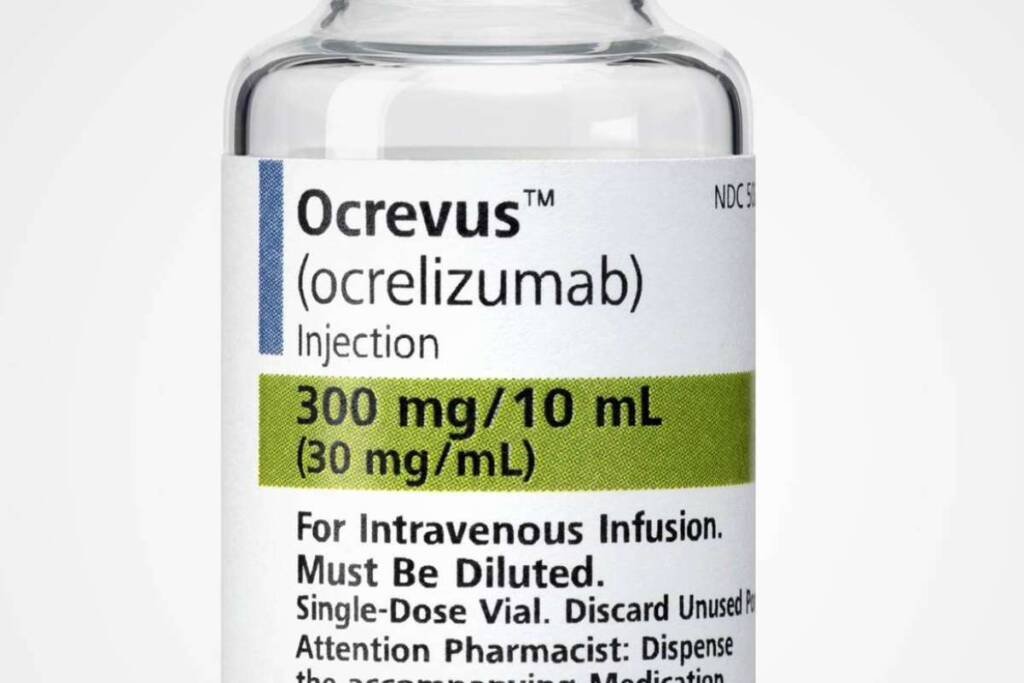Source – Roche
On 13 July Roche announced positive results from the Phase III OCARINA II trial, which investigated the use of OCREVUS (ocrelizumab) as a subcutaneous injection given twice a year for only 10 minutes. The trial met its primary and secondary objectives in patients with relapsing forms of multiple sclerosis (MS) or primary progressive MS (PPMS). The subcutaneous injection of OCREVUS was found to be equally effective as the intravenous (IV) infusion in terms of pharmacokinetics (levels in the blood) over a period of 12 weeks. Additionally, the subcutaneous injection showed similar results to the IV infusion in controlling magnetic resonance imaging (MRI) lesion activity in the brain over the same 12-week period. The safety profile of the subcutaneous injection was consistent with that of the IV infusion.
The 10-minute OCREVUS injection is designed to be administered without the need for IV infrastructure. This feature has the potential to expand the usage of OCREVUS in MS centers that lack IV infrastructure or have limitations in IV capacity. Furthermore, it maintains the twice-yearly dosing schedule of the IV form, which has demonstrated high persistence and adherence as a standard treatment for MS. This additional delivery option allows the administration of OCREVUS to be tailored to the individual needs of patients and healthcare professionals.
“These results give people living with MS the possibility to receive the transformational benefits of OCREVUS in the way best suited to their lives while freeing up time and healthcare resources. This new subcutaneous injection will allow OCREVUS to be administered in 10 minutes twice a year, helping people living with MS to spend less time in treatment for this disease.’’
– Levi Garraway, M.D., Ph.D., Roche’s Chief Medical Officer and Head of Global Product Development
Detailed trial results will be presented at an upcoming medical meeting and submitted to health authorities worldwide. Roche remains committed to advancing innovative clinical research programs to enhance the scientific understanding of MS, reduce disability progression in both relapsing MS and primary progressive MS, and improve treatment experiences for individuals living with the disease.
The OCARINA II trial is a Phase III, global, multicenter, randomized study involving 236 patients with relapsing MS or primary progressive MS. It aims to evaluate the pharmacokinetics, safety, and radiological and clinical effects of the subcutaneous formulation of OCREVUS compared to the IV infusion. The primary endpoint of the trial is to establish the non-inferiority of the subcutaneous injection in terms of serum area under the curve (AUC) from day 1 to 12 weeks after injection, as compared to the IV infusion. Secondary endpoints include the maximum serum concentration (Cmax) of OCREVUS, the number of active gadolinium-enhancing T1 lesions at 8 and 12 weeks, new or enlarging T2 lesions at 12 and 24 weeks, as well as safety and immunogenicity outcomes. Patient-reported outcomes are also being explored as additional endpoints.
The subcutaneous formulation of OCREVUS combines the drug with Halozyme Therapeutics’ Enhanze drug delivery technology. OCREVUS is a humanized monoclonal antibody designed to target CD20-positive B cells, a specific type of immune cell believed to contribute to nerve cell damage in MS. The Enhanze technology utilizes an enzyme called recombinant human hyaluronidase PH20 (rHuPH20), which temporarily degrades hyaluronan, a natural sugar chain in the body, in the subcutaneous space. This degradation increases the permeability of the tissue under the skin, allowing large molecules like OCREVUS to enter and be rapidly absorbed into the bloodstream.
OCREVUS IV is currently the only approved therapy for both relapsing MS (including relapsing-remitting MS [RRMS], active, or relapsing secondary progressive MS [SPMS], and clinically isolated syndrome [CIS] in the US) and PPMS. The IV formulation is administered through an intravenous infusion every six months, with an initial dose given as two 300 mg infusions two weeks apart, followed by subsequent single 600 mg infusions.





























